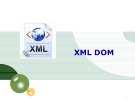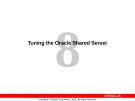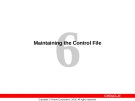
XML In Server
-
Bài giảng Lập trình hướng đối tượng - XML DOM có cấu trúc gồm 4 phần cung cấp cho người học các nội dung: Tính chất và đặc điểm, DOM node tree và node types, XML DOM và Javascript, XML In Server. Mời các bạn cùng tham khảo nội dung chi tiết.
 121p
121p  thangnamvoiva20
thangnamvoiva20
 20-09-2016
20-09-2016
 70
70
 8
8
 Download
Download
-
Users and Security Security domain The database administrator defines the names of the users who are allowed to access a database. A security domain defines the settings that apply to the user. Authentication mechanism A user who requires access to the database can be authenticated by one of the following: Data dictionary Operating system Network The means of authentication is specified at the time the user is defined in the database and can be altered later. This lesson covers authentication by database and by operating system only.
 20p
20p  trinh02
trinh02
 28-01-2013
28-01-2013
 83
83
 3
3
 Download
Download
-
After completing this lesson, you should be able to do the following: Identify issues associated with managing users in an Oracle Shared Server environment Configure the Oracle Shared Server environment to optimize performance Diagnose and resolve performance issues with Oracle Shared Server processes
 14p
14p  trinh02
trinh02
 28-01-2013
28-01-2013
 61
61
 5
5
 Download
Download
-
Control File The control file is a small binary file necessary for the database to start and operate successfully. Each control file is associated with only one Oracle database. Before a database is opened, the control file is read to determine whether the database is in a valid state to use. A control file is updated continuously by the Oracle server during database use, so it must be available for writing whenever the database is open. The information in the control file can be modified only by the Oracle server; no database administrator or end user can edit the control file....
 16p
16p  trinh02
trinh02
 28-01-2013
28-01-2013
 63
63
 3
3
 Download
Download
-
Before a database is created, the UNIX environment must be configured and the Oracle9i server must have already been installed. Four environment variables must be set: ORACLE_HOME, ORACLE_SID, PATH, LD_LIBRARY_PATH. ORACLE_HOME is the full path to the top directory in which the Oracle9i Server is installed. The directory for ORACLE_HOME should be supplied by the person who installed the server, usually the UNIX administrator or the DBA. ORACLE_SID is a user-definable name assigned to an instance of a database.
 10p
10p  trinh02
trinh02
 28-01-2013
28-01-2013
 65
65
 6
6
 Download
Download
-
Restoration and Datafile Media Recovery Using RMAN RMAN automates the procedure for restoring files. When you issue the RESTORE command, RMAN uses a server session to restore the correct backups and copies. The RMAN repository is used to select the best available backup set or image copies to use in the restoration. By default, RMAN does not restore a file if the file is already in the correct place and its header contains the correct information. In releases before Oracle9i, the files were always restored.
 16p
16p  trinh02
trinh02
 28-01-2013
28-01-2013
 60
60
 7
7
 Download
Download
-
Chapter 17 provided a description of the protocols at the user’s disposal for configuring services on the Internet. We saw that the service configuration architecture assumes an XML document stored on a server. The client retrieves a copy of the XML document, makes changes to it, and sends the delta back to the server. In IMS, the architecture for service configuration architecture is developed around the XML Document Management (XDM) architecture created by the Open Mobile Alliance (OMA) in the XDM [244] set of specifications. ...
 15p
15p  0984272663
0984272663
 27-04-2011
27-04-2011
 89
89
 6
6
 Download
Download
-
[ Team LiB ] Recipe 9.5 Performing a Bulk Insert with SQL Server Problem Given many records in an XML file that you need to add to a SQL Server 2000 database, you need to perform a bulk insert with optimal performance.
 5p
5p  luvpro
luvpro
 04-08-2010
04-08-2010
 118
118
 13
13
 Download
Download
-
[ Team LiB ] Recipe 8.5 Reading XML Data Directly from SQL Server Problem You need to read XML data directly from the SQL Server. Solution Use the FOR XML clause in the stored procedure or SQL statement. The C# code is shown in Example 8-8. Example 8-8. File
 2p
2p  luvpro
luvpro
 04-08-2010
04-08-2010
 148
148
 16
16
 Download
Download
CHỦ ĐỀ BẠN MUỐN TÌM





















